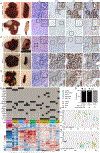Human Hepatocytes Can Give Rise to Intrahepatic Cholangiocarcinomas
- PMID: 38866344
- PMCID: PMC11753062
- DOI: 10.1053/j.gastro.2024.05.033
Human Hepatocytes Can Give Rise to Intrahepatic Cholangiocarcinomas
Conflict of interest statement
Conflicts of interest
These authors disclose the following: Chise Tateno and Yuji Ishida are employees of PhoenixBio Co, Ltd. The remaining authors disclose no conflicts.
Figures

References
-
- Nakanuma Y, et al. WHO classification of digestive system tumours. In: WHO classification of tumours. 5th ed. Lyon: IARC Press, 2019.
MeSH terms
Grants and funding
LinkOut - more resources
Full Text Sources
Medical
Molecular Biology Databases

